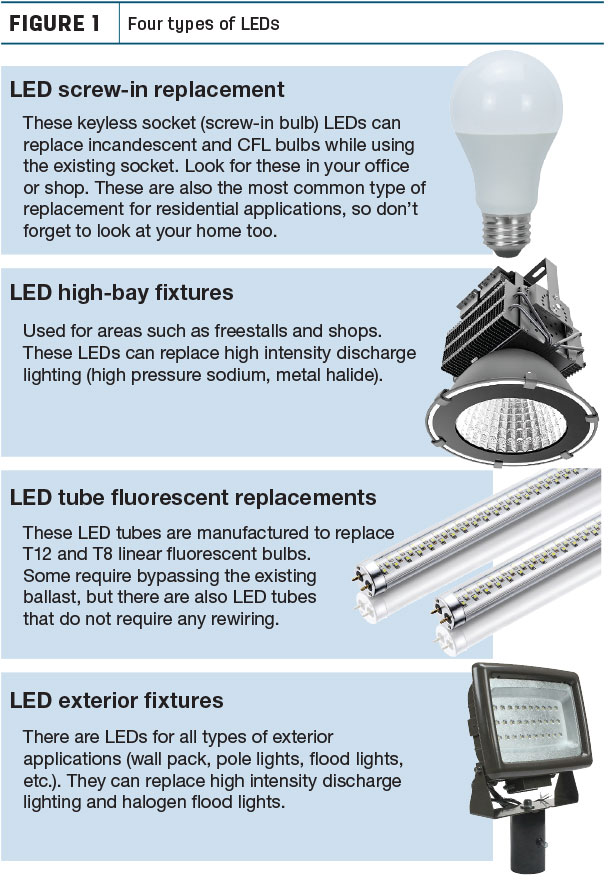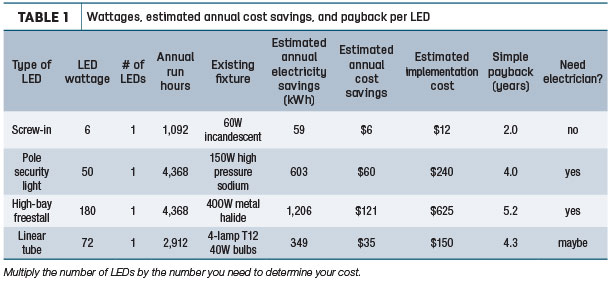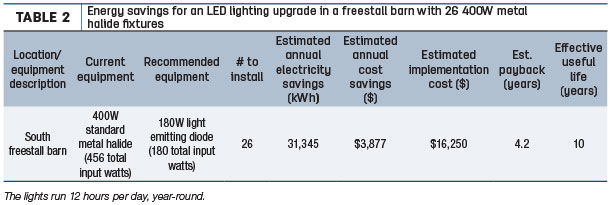LEDs have come a long way in the past decade and have established themselves as mainstream lighting technology. Early LED lights could be unreliable and expensive, and some dairies were skeptical about the new lighting’s effect on herd health and milk production.
Recent studies have laid these concerns to rest, and LEDs are also much cheaper and more widely available than they used to be.
If you’re intrigued by LED lighting for your farm but don’t know much about it, let’s take a closer look. LED stands for “light emitting diode” – a type of semiconductor used to produce light. They typically consume about 50 to 75 percent less energy than comparable lighting technologies such as incandescent, fluorescent, mercury vapor, metal halide, halogen and high-pressure sodium.
If you are looking to replace lighting in your dairy, LEDs represent the best option for almost all applications. There are still some situations where T8 and T5 linear fluorescents can be appropriate, but they are becoming more limited.
There are several different types of LEDs on the market, and it is important to know which LEDs are appropriate for your application. Refer to Figure 1 for examples of the four types of LED lights and their best uses.

Benefits
LEDs provide the greatest energy savings of any lighting technology, consuming 50 to 75 percent less energy than other types of lighting. They also have a long useful life of about 40,000 to 50,000 hours, at least twice the lifetime of most other types of lighting.
LEDs do not contain mercury, so you do not have to worry about hazardous waste disposal. LEDs have a high color rendering index (CRI), meaning that the light is high-quality and allows for better reproduction of color. This is especially important for cow health and worker comfort and safety.
How to choose a quality product
Choose lights that are listed on Design Lights Consortium’s qualified product list (www.designlights.org/search). The Design Lights Consortium is a non-profit organization dedicated to accelerating the widespread adoption of high-performing commercial lighting solutions.
Look for an ingress protection rating of 65 or greater. A higher rating means better protection from moisture and dust, which is especially critical in a farm environment. Most quality LEDs come with a three-year warranty or greater.
Table 1 shows the wattages, estimated annual cost savings and payback per LED. Multiply the number of LEDs by the number you need to determine your cost.

Let’s take a look at a real-life example from one of our energy audits. In Table 2 is the energy savings for an LED lighting upgrade in a freestall barn with 26 400-watt metal halide fixtures. The lights run 12 hours per day, year-round.

Funding for LED lighting
You may be able to receive incentives to help offset the cost of your LED lighting purchase. The USDA Natural Resources Conservation Service funds LED lighting retrofits through the Environmental Quality Incentives Program. Call your local USDA Service Center to find out more. You can also apply for grants or low-interest loans through USDA Rural Development’s REAP program.
Your local electric utility may offer rebates for LED installations as well. Call the customer service number on your electric bill or check their website to see if any products are on offer.
Even without incentives, LEDs are one of the fastest-payback energy upgrades a dairy can make. With LEDs now solidly established as the best choice for lighting, consider upgrading your dairy now to save on energy costs and put more money in your pocket. ![]()

-
Kyle Booth
- Engineering Team Lead, CEM
- EnSave Inc.
- Email Kyle Booth






